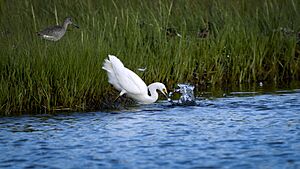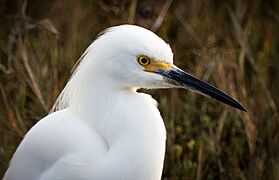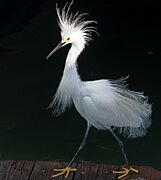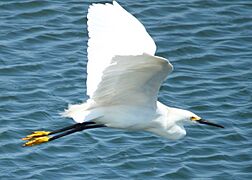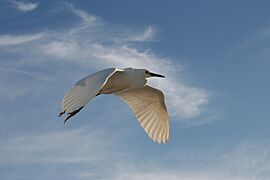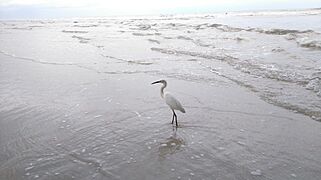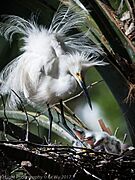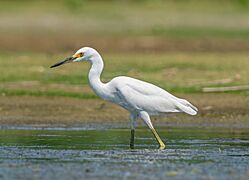Snowy egret facts for kids
Quick facts for kids Snowy egret |
|
|---|---|
 |
|
| Conservation status | |
| Scientific classification | |
| Genus: |
Egretta
|
| Species: |
thula
|
 |
|
| Range of E. thula Breeding range Year-round range Wintering range | |
| Synonyms | |
|
|
The snowy egret (Egretta thula) is a beautiful small white heron. Its name, Egretta, comes from a French word for a small heron. The second part, thula, was mistakenly given by a scientist who thought it was the name for a different bird.
Snowy egrets are like the little egrets found in other parts of the world. Long ago, people hunted these birds a lot. Their fancy feathers were very popular for decorating women's hats. This hunting made their numbers drop dangerously low. Luckily, laws like the Migratory Bird Treaty Act now protect them in the United States. Because of these laws, the snowy egret population has grown back.
Contents
What Does a Snowy Egret Look Like?
Adult snowy egrets are completely white. They have bright yellow skin around their eyes, a long black beak, and black legs. Their feet are a very bright yellow!
On their neck and back of their head, they have long, shaggy feathers. These special feathers are called aigrettes. Young snowy egrets, called immatures, have duller, greenish legs instead of black.
Measurements:
- Length: About 56 to 66 centimeters (22 to 26 inches)
- Weight: Around 370 grams (13 ounces)
- Wingspan: About 100 centimeters (39 inches)
Where Do Snowy Egrets Live?
Snowy egrets live in North, Central, and South America. You can find them all year round in South America, even as far south as Chile and Argentina. They also stay all year in the West Indies, Florida, and along the coasts of North and Central America.
In the southern United States, they move around. They breed in states like California, Texas, and Louisiana. These birds love wetlands, which are wet, marshy areas. They live near rivers, lakes, ponds, and in salt marshes. They usually do not live in high mountains or right on the ocean coast.
Sometimes, a snowy egret might fly far off course. This is called being a vagrant. They have been seen in places like Iceland and South Africa!
What Do Snowy Egrets Eat?
Snowy egrets are skilled hunters. They eat many different things found in water. Their diet includes fish, crustaceans like crabs and shrimp, and insects. They also eat small reptiles such as lizards, snails, frogs, and worms.
They hunt in shallow water. Often, they run or shuffle their feet to scare prey into view. They might sway their heads, flick their wings, or vibrate their beaks to stir up food. Sometimes, they hover just above the water or fly with their feet barely touching the surface to catch fish. They can also stand very still and wait to ambush their prey. You might even see them hunting for insects in fields where farm animals have stirred them up. They sometimes hunt with other types of birds.
Snowy Egret Reproduction and Life Cycle
Snowy egrets build their nests in large groups called colonies. These colonies often include other types of herons and birds like glossy ibises.
First, the male egret chooses a spot and starts building a nest. He usually picks a tree, some thick vines, or bushes. Then, he tries to attract a female with a special dance. This dance includes dipping up and down, raising his beak, flying around, and making calls.
Once a female joins him, she finishes building the nest. The male brings her twigs, grass, and other materials. The nest can be about 38 centimeters (15 inches) wide. The female lays up to six pale bluish-green eggs. These eggs hatch after about 24 days.
When the chicks hatch, they are helpless and covered in white fuzz. This is called being altricial. They stay in the nest for about 22 days before they are ready to leave.
Ancient Snowy Egret Finds
Scientists have found fossils of snowy egrets in different places. Some were found in tar pits in Peru. Others were discovered in Florida, United States. These fossils show that snowy egrets have been around since the Late Pleistocene period, which was a very long time ago.
How Are Snowy Egret Populations Doing?
At the start of the 1900s, snowy egrets were hunted a lot for their long, beautiful feathers. These feathers were very popular for decorating hats. This hunting stopped in North America by 1910, but continued for a while in Central and South America.
Since then, the number of snowy egrets has grown back. The bird lives in a very large area, and there are many of them. Scientists have not found any major threats to them right now. Their population seems to be increasing. Because of this, the International Union for Conservation of Nature says the snowy egret is a species of "least concern". This means they are not currently in danger of disappearing.
Gallery



